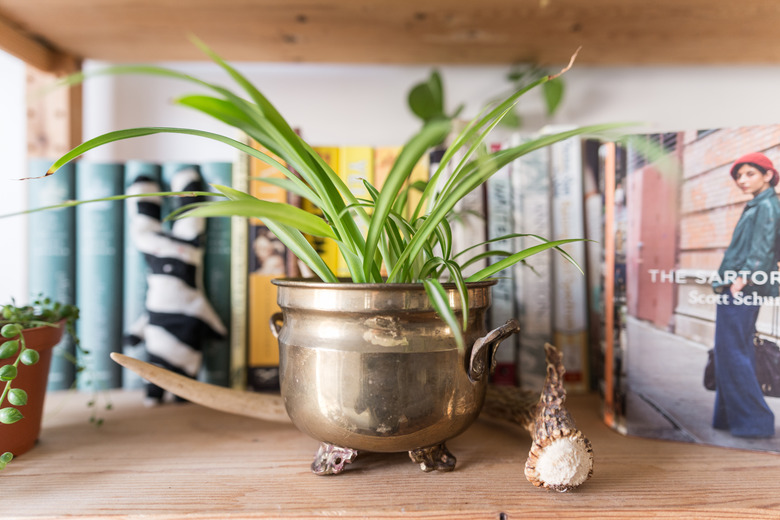Are You A Houseplant Killer? 7 Deadly Sins You Need To Stop Doing
Lots of well-meaning people end up killing off their houseplants and then are wracked with regret. They don't mean to (of course), however, they just don't know what they did wrong!
If this sounds like you, no more gnashing of teeth and beating of breast necessary. You can avoid becoming a career plant-killing criminal simply by gaining an understanding of what they absolutely won't stand. Here are the worst practices that account for houseplant deaths.
1. Too Much Water
1. Too Much Water
The number one cause of household plant demise in America is not creepy bugs nor deadly diseases. It's simply overwatering. Everyone knows that plants need some water, so a little extra won't hurt, right? Wrong. Your plant can die if you give it too much H2O. If your houseplant's soil is waterlogged, those vital roots might rot.
How much is too much? That question depends entirely on the plant in question, the season and the exposure to sunlight. Some plants, like succulents and cacti, need to dry out completely between drinks. Others need constantly moist soil to survive. Some plants' water needs go way down in winter dormancy. Your houseplant probably came with care instructions, and those are a great place to start. (Also, check out Hunker's Definitive Guide to Caring for a Fiddle-Leaf Fig Tree, or simply purchase a houseplant that is pretty much unkillable.)
2. Inadequate Drainage
2. Inadequate Drainage
Poor drainage is closely related to overwatering, and the end result is the same: the plant's roots drown or rot. Think of a plant growing in the wild. The rain falls from the sky, moistens the soil. The plant uptakes the water it needs with its roots, and the rest of the water drains away or evaporates. That is your role model for drainage. The plant should be offered water at appropriate intervals, and what it doesn't need should not hang around its roots.
Check the bottoms of all your houseplant pots to look for holes. Sometimes, houseplants are sold in decorative containers without holes, but this often is fatal for the plant. Sometimes, a houseplant is planted in heavy soil with poor drainage, instead of potting soil. And, if you keep a saucer beneath the plant, you'll need to empty it regularly. It's better to water the plant at the sink, then let it drain before replacing it on its saucer.
3. Too Little Water
3. Too Little Water
All plants need water, even those native to the desert. Some, like succulents, are more adept at storing water when they get it, and others are drought tolerant. But none will live very long without a drink.
Depriving a houseplant of water is another of the top causes of plant demise. Some people view their houseplants as pretty decorative objects and forget that they are living beings. Others go away on vacation without arranging houseplant care and hope for the best.
To prevent this outcome, establish a regular watering schedule for your plants. If you are going away for more than a few days, buy an automatic watering system or arrange for a plant sitter.
4. Inadequate Light
4. Inadequate Light
Plants manufacture energy from sunlight and air and need both to survive. So, it's natural that inadequate light is another frequent cause of houseplant death. If you put any plant in a dark closet, it will die.
Each species of plant needs a different amount of sun exposure. If you provide a particular plant with far less than it requires, it won't last long. Many flowering plants require full sun, so confining them in a dim bathroom won't give them what they need to photosynthesize. But some plants would do just fine in low-light and perish in direct afternoon heat.
Take the time to consider the type of exposure available in your home before buying houseplants. Then, put each one in a spot where it can thrive.
5. Too Hot Plant Spot
5. Too Hot Plant Spot
Most houseplants prefer the same type of temperature range that you enjoy, between 50 and 70 degrees Fahrenheit or so. Extreme temperatures at either end of the spectrum can be the death of a plant.
One common death trap for a houseplant is the house radiator. It's the perfect width to place a good-sized plant, but look out. When that radiator comes on, the plant will cook. Likewise, plants placed close to heat sources will suffer too and may not make it. Another destructive plant practice is leaving heat-loving plants on cold window sills through winter.
6. Dirty Leaves
6. Dirty Leaves
Houseplant leaves get dusty just like the rest of the flat surfaces in your apartment. Outdoors, leaves get natural showers, but indoors, that dirt builds up and can even get in the way of photosynthesis. Dusty leaves mean clogged plant pores (stomata), making it difficult for the plant to "breathe."
You don't have to give your plants a bubble bath. Just wipe down their leaves with a damp sponge once in a while.
7. Overfeeding Kills, Too
7. Overfeeding Kills, Too
All plants need nitrogen, phosphorus, and potassium to thrive, and sometimes they can't get enough of it from the soil. Adding a balanced fertilizer in appropriate amounts can keep houseplants healthier, but it's rarely a life-and-death issue.
On the other hand, too much fertilizer can kill. Just like overwatering, excess feeding can be lethal to a houseplant, and you'll see the leaves get soft and the plant wilt and brown. Ditto for feeding at the wrong time. For example, most plants need little or no feeding during the winter. Either figure out how much fertilizer a particular plant needs, or just don't feed it at all.
